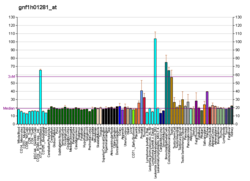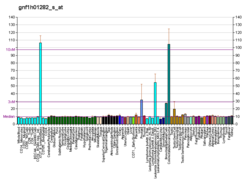| BAIAP2L1 |
|---|
 |
| Available structures |
|---|
| PDB | Ortholog search: PDBe RCSB |
|---|
| List of PDB id codes |
|---|
2KXC, 2LNH |
|
|
| Identifiers |
|---|
| Aliases | BAIAP2L1, IRTKS, BAI1 associated protein 2 like 1, BAR/IMD domain containing adaptor protein 2 like 1 |
|---|
| External IDs | OMIM: 611877; MGI: 1914148; HomoloGene: 23123; GeneCards: BAIAP2L1; OMA:BAIAP2L1 - orthologs |
|---|
| Gene location (Human) |
|---|
 | | Chr. | Chromosome 7 (human)[1] |
|---|
| | Band | 7q21.3-q22.1 | Start | 98,291,650 bp[1] |
|---|
| End | 98,401,090 bp[1] |
|---|
|
| Gene location (Mouse) |
|---|
 | | Chr. | Chromosome 5 (mouse)[2] |
|---|
| | Band | 5|5 G2 | Start | 144,201,336 bp[2] |
|---|
| End | 144,294,922 bp[2] |
|---|
|
| RNA expression pattern |
|---|
| Bgee | | Human | Mouse (ortholog) |
|---|
| Top expressed in | - pancreatic ductal cell
- secondary oocyte
- tendon of biceps brachii
- amniotic fluid
- cartilage tissue
- bronchial epithelial cell
- duodenum
- mucosa of ileum
- mucosa of transverse colon
- olfactory zone of nasal mucosa
|
| | Top expressed in | - secondary oocyte
- primary oocyte
- zygote
- right lung lobe
- left colon
- lumbar spinal ganglion
- epithelium of stomach
- pyloric antrum
- mucous cell of stomach
- otic placode
|
| | More reference expression data |
|
|---|
| BioGPS | 
 | | More reference expression data |
|
|---|
|
| Gene ontology |
|---|
| Molecular function | - actin binding
- proline-rich region binding
- protein binding
- cadherin binding involved in cell-cell adhesion
| | Cellular component | - cytosol
- plasma membrane
- extracellular exosome
- cytoskeleton
- nucleoplasm
- actin cytoskeleton
- cytoplasm
| | Biological process | - insulin receptor signaling pathway
- regulation of actin filament polymerization
- plasma membrane organization
- positive regulation of actin cytoskeleton reorganization
- positive regulation of actin filament polymerization
- response to bacterium
- regulation of insulin receptor signaling pathway
- actin filament bundle assembly
- actin crosslink formation
- cell-cell adhesion
| | Sources:Amigo / QuickGO |
|
|
| Wikidata |
| View/Edit Human | View/Edit Mouse |
|

 1spk: Solution Structure of RSGI RUH-010, an SH3 Domain from Mouse cDNA
1spk: Solution Structure of RSGI RUH-010, an SH3 Domain from Mouse cDNA





















